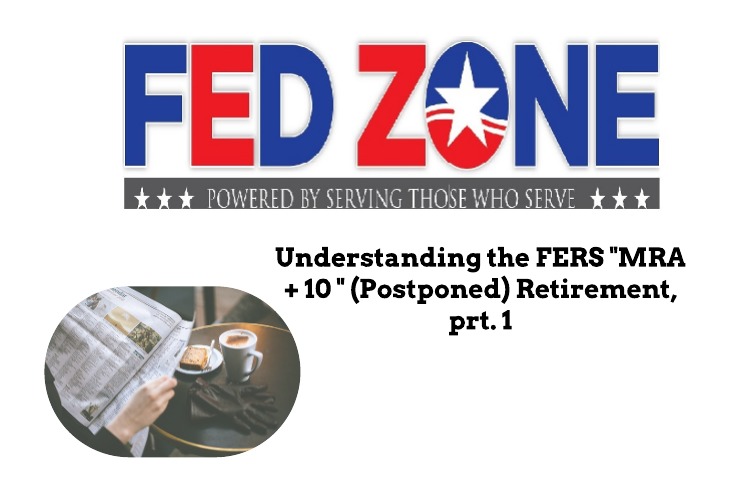Edward A. Zurndorfer
Employees who are covered by the Federal Employees Retirement System (FERS) are eligible to retire optionally with an immediate reduced annuity under what is called an “MRA + 10” (sometimes called a “postponed”)FERS annuity if certain requirements are met. This is the first of two FEDZONE columns discussing the “MRA+10” retirement available to many FERS employees. This first column discusses employee eligibility requirements, when the FERS annuity starts, and the permanent reduction of the annuity when the retired employee is below a certain age.
There are five conditions an employee must fulfill in order to be eligible for an “MRA+10” FERS retirement. These conditions are: (1) Minimum civilian service requirement; (2) reaching at least one’s minimum retirement age (MRA); (3) 10-year minimum service requirement; (4) separation from a position subject to FERS coverage; and (5) no entitlement to an immediate FERS annuity based upon age and service. These five conditions are now discussed.
- Minimum civilian service. An employee must have at least five years of creditable civilian service to be eligible for an MRA+10 retirement annuity. Creditable civilian service for this purpose includes: (1) Service for which FERS contributions (via payroll deduction equal to 0.8, 3.1, 4.4 percent of an employee’s salary) were made and not refunded; (2) temporary or intermittent service performed prior to January 1, 1989, if a full deposit for such service is made or deemed made under the alternative annuity provisions; and (3) service for which full Social Security taxes and full or reduced CSRS deductions were not refunded after the employee was covered by FERS. For individuals also eligible for a CSRS annuity component to their FERS retirement, service for which full CSRS deductions were taken, even if CSRS deductions were refunded and not redeposited.
- Minimum Retirement Age (MRA). MRA is the earliest age at which an employee may retire with an immediate reduced annuity after 10 to 29 years of service, or with an unreduced annuity after 30 years of service. The MRA increases over time based on an employee’s year of birth and ranges between ages 55 and 57. To determine an employee’s MRA, refer to the table below.
| If year of birth is…. | then the Minimum Retirement Age (MRA) is age… |
| Before 1948 1948 1949 1940 1951 1952 1952-1964 1965 1966 1967 1968 1969 1970 and after | 55 55 and 2 months 55 and 4 months 55 and 6 months 55 and 8 months 55 and 10 months 56 56 and 2 months 56 and 4 months 56 and 6 months 56 and 8 months 56 and 10 months 57 |
- 10-year service requirement. An employee must have at least 10 years of creditable civilian and military service to be eligible for an MRA + 10 annuity. Note the following: (1) At least five years have to be civilian service; and (2) post-1956 military service cannot be used to meet the 10-year service requirement unless the employee makes the full military service deposit before separation.
- The employee must be separated from a position covered by FERS deductions.
- No entitlement to an immediate regular retirement under regular voluntary provisions. The employee cannot be entitled to an immediate annuity under the regular retirement provisions of FERS. For example, a FERS employee could be eligible for an immediate annuity based on being age 60 with 20 years of service. In short, a FERS employee must meet one of the age and service requirements below at separation in order to be eligible for a “MRA + 10” FERS annuity.
| Age at Retirement | At least 10 years creditable service but less than … |
| MRA to Age 59 Age 60-61 | 30 20 |
Commencing Date of MRA+10 FERS Annuity
Except as explained below, the commencing date of the “MRA+10” FERS annuity is the first day of the month following the employee’s separation regardless of whether the separation is voluntary or involuntary. The following examples illustrate:
Example 1. Date of separation: September 30
Annuity commences: October 1
Example 2. Date of separation: April 10
Annuity commences: May 1
There are two exceptions to the starting date of the “MRA+10” FERS annuity being the first day of the month following the employee’s separation. These exceptions are:
- Expiration of a term appointment. If the separation upon which an “MRA+10” retirement is based occurs because of the expiration of a term or other period for which the person was appointed or elected, then the annuity commences the day after separation. This exception includes separation based on the expiration of a term appointment or other time-limited appointment.
- Postponed annuity. Former employees who choose a postponed annuity may elect to have the “MRA+10” FERS annuity postponed and then commence on any day after the first day of any month following separation from federal service, up to and including the second day before the employee’s 62nd birthday. The reason why an employee would want to postpone the start of his or her MRA+10 FERS annuity is now discussed.
FERS annuity reduction for age under the MRA+10 Retirement
For employees under age 60 with 10 to 19 years of service, the FERS annual annuity is reduced by 5/12 of one percent for each full month by which the commencing date of annuity precedes the 62nd birthday of the departed employee. In short, the reduction is five percent for each year the employee is under age 62. The reduction is permanent and does not stop when the retiree reaches age 62. The following example illustrates:
Judy is a FERS employee who elected the MRA +10 FERS retirement at age 57 on April 30, 2020. Judy had 15 years of creditable service and has a high-three average salary of $100,000. Judy also had six months of unused sick leave at the time of her retirement. Judy becomes age 62 on April 20, 2025.
Judy’s annual annuity is computed as follows:
Unreduced annual annuity: $100,000 (high-three average salary)
times 15.5 years of service (includes 6 months of unused sick leave)
times 1 percent = $15,500
Judy will not be age 62 for five years (60 months) so that the reduction is:
60 months times 5/12 times one percent, or 25 percent
25 percent x $15,500 = $3,875
Judy’s reduced annuity = $15,500 less $3,875 = $11,625
Judy’s annual annuity of $11,625, or monthly annuity of $11,625/12 or $968.75, starts June 1, 2020 and will continue at the same amount until Judy becomes age 62. Judy will then become eligible for annual FERS cost-of-living adjustments (COLA’s).
Note that if Judy elects to postpone the start of her FERS annuity, for every month that she postpones the start of her annuity until age 62, the reduction will be 5/12 of one percent less. For example, if she waits until age 58, her annuity will be reduced 20 percent.
For employees under age 60 with 20 to 29 years of service, the FERS annual annuity is reduced by 5/12 of one percent for each full month by which the commencing date of the annuity precedes the 60th birthday of the employee. The reduction is five percent for each year the employee is under age 60. The reduction is permanent and does not stop when the retiree becomes age 60. The following example illustrates:
Jerry is a FERS employee who elected to leave federal service at age 58 on April 30, 2020. Jerry had 22 years of creditable service and has a high-three average salary of $125,000. Jerry also has one year’s worth of unused sick leave at the time of his retirement. Jerry will become age 60 on April 15, 2022.
Jerry’s annual annuity is computed as follows:
Unreduced annual annuity: $125,000 (high-three average salary)
times 23 years of service (includes one year’s worth of unused sick leave)
times one percent = $28,750
Jerry will not be age 60 for two years (24 months) so that the reduction is:
24 months x (5/12 x 1 percent) per month = 10 percent
10 percent times $28,750 = $2,875
Jerry’s reduced annuity = $28,750 less $2,875 = $25,875
Jerry’s annual annuity of $25,875 or monthly annuity of $25,875/12 equals $2,156.25 starts June 1, 2020 and will continue at the same amount until Jerry becomes age 62. Jerry will then be eligible for annual FERS cost-of-living adjustments (COLAs).
Note that if Jerry elects to postpone the start of his FERS annuity, for every month that he postpones the start of his annuity until age 60 the reduction will be 5/12 of one percent less. For example, if he waits until age 59, his annuity will be reduced 5 percent.

Edward A. Zurndorfer is a CERTIFIED FINANCIAL PLANNER™ professional, Chartered Life Underwriter, Chartered Financial Consultant, Chartered Federal Employee Benefits Consultant, Certified Employees Benefits Specialist and IRS Enrolled Agent in Silver Spring, MD. Tax planning, Federal employee benefits, retirement and insurance consulting services offered through EZ Accounting and Financial Services, and EZ Federal Benefits Seminars, located at 833 Bromley Street – Suite A, Silver Spring, MD 20902-3019 and telephone number 301-681-1652. Raymond James is not affiliated with and does not endorse the opinions or services of Edward A. Zurndorfer or EZ Accounting and Financial Services. The information has been obtained from sources considered to be reliable, but we do not guarantee that the foregoing material is accurate or complete. While we are familiar with the tax provisions of the issues presented herein, as Financial Advisors of RJFS, we are not qualified to render advice on tax or legal matters. You should discuss tax or legal matters with the appropriate professional.
Postponed Retirement
